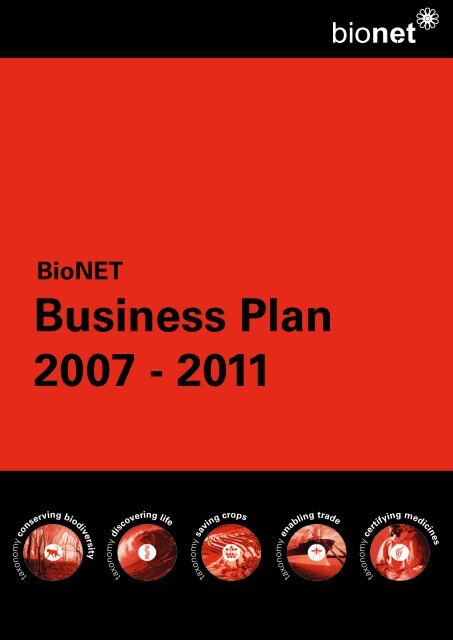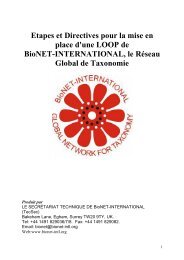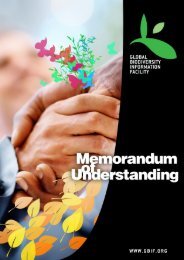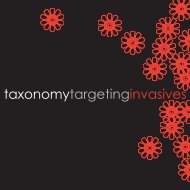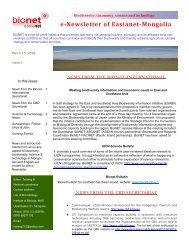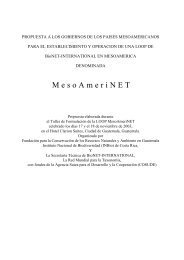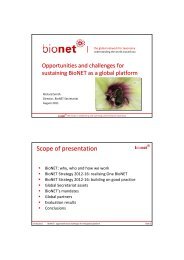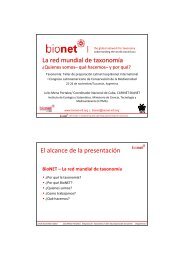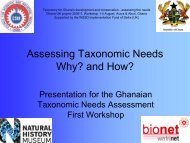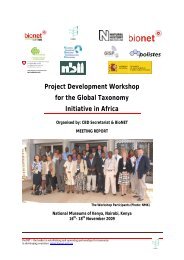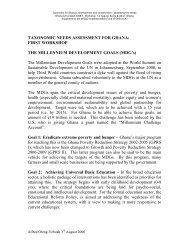Business Plan 2007 - 2011 - BioNET
Business Plan 2007 - 2011 - BioNET
Business Plan 2007 - 2011 - BioNET
Create successful ePaper yourself
Turn your PDF publications into a flip-book with our unique Google optimized e-Paper software.
<strong>BioNET</strong><br />
<strong>Business</strong> <strong>Plan</strong><br />
<strong>2007</strong> - <strong>2011</strong><br />
taxonomy conserving biodiversity<br />
taxonomy discovering life<br />
taxonomy saving crops<br />
taxonomy enabling trade<br />
taxonomy certifying medicines
the global network for taxonomy<br />
***<br />
Increase your options with names!
www.bionet-intl.org<br />
<strong>BioNET</strong>’s Vision<br />
The capacity to name all living organisms is<br />
accessible to serve the needs of<br />
people everywhere.<br />
<strong>BioNET</strong>’s Mission<br />
Enhance human well-being and biodiversity<br />
conservation by building capacity to<br />
discover, name and classify the<br />
world’s living organisms.
the global network for taxonomy<br />
Contents<br />
1 Key Messages<br />
3 Introduction<br />
3 The Organisation<br />
7 <strong>BioNET</strong>’s Markets, Services and Niche<br />
9 The Global Programme <strong>2007</strong>-<strong>2011</strong><br />
10 Management Summary<br />
10 Financing and Funding<br />
13 Risks and Keys to Success
www.bionet-intl.org<br />
KEY MESSAGES<br />
<strong>BioNET</strong>’s goal is for anyone, anywhere in the<br />
World, to be able to find the correct name for<br />
any plant, animal, fungi or micro-organism.<br />
<strong>BioNET</strong> is achieving this by building capacity and<br />
partnerships globally.<br />
Naming organisms enables us to manage the<br />
world sustainably, understand our impact upon<br />
it, and the effects of our changing environment.<br />
It is integral to achieving the Millennium Development<br />
Goals and meeting agriculture, trade,<br />
health, food security and other needs of countries<br />
world-wide.<br />
Taxonomy is the science of discovery, naming<br />
and classification of all living things.<br />
Taxonomic Impediment – The job of providing<br />
names falls on a very few individuals and institutions.<br />
Capacity is wholly insufficient to respond<br />
appropriately to people who need names to<br />
manage biodiversity, support agriculture, promote<br />
health and regulate trade. The Impediment<br />
is acute in most developing countries.<br />
<strong>BioNET</strong>’s Mission is to “enhance human wellbeing<br />
and biodiversity conservation by building<br />
capacity to discover, name and classify the<br />
world’s living organisms”. <strong>BioNET</strong> is the leader<br />
in establishing and operating partnerships for<br />
capacity building and advocacy for taxonomy in<br />
developing countries.<br />
The organisation is not-for-profit and distributed<br />
world-wide, with a UK-based Secretariat<br />
and ten locally managed, government-endorsed,<br />
regional partnerships encompassing institutions<br />
in 115 countries in Africa, Asia and Oceania, the<br />
Caribbean and Latin America. CABI, an international<br />
not-for-profit organisation, provides the<br />
legal framework and hosting services for the<br />
Secretariat.<br />
The <strong>BioNET</strong> Strategy – The regional partnerships<br />
are <strong>BioNET</strong>’s unique capacity building<br />
and product delivery mechanisms. Their local<br />
know-how is complemented by the Secretariat’s<br />
in-depth knowledge of international taxonomic<br />
priorities and its strategic partnerships with leading<br />
international technology and capacity building<br />
organisations.<br />
Achievements – <strong>BioNET</strong> has a strong record in<br />
capacity building and is highly regarded internationally.<br />
Key decisions of the Convention on<br />
Biological Diversity identify roles for <strong>BioNET</strong>,<br />
recognising it as the “most comprehensive network<br />
for taxonomy”. <strong>BioNET</strong>’s success depends<br />
on effective mobilisation of partnerships both<br />
locally and internationally.<br />
The Global Programme <strong>2007</strong>-<strong>2011</strong> – <strong>BioNET</strong>’s<br />
role has grown among international organisations<br />
and demands on its centrally-managed services<br />
have evolved and are increasing. Following<br />
the successes of establishing regional partnerships,<br />
the new Global Programme is product<br />
oriented. It identifies four key areas of work: A)<br />
fortifying <strong>BioNET</strong>’s delivery platform (regional<br />
partnerships), B) accelerating the development<br />
of products with technology partners, C) creating<br />
an enabling policy environment and D) mobilising<br />
resources for taxonomy.<br />
<strong>BioNET</strong>’s Funding Needs – Increased operational<br />
and human resources will be needed to<br />
realise the ambitious yet realistic goals of the<br />
Global Programme. The total cost of the Global<br />
Programme (<strong>2007</strong> to <strong>2011</strong>) will be £3.14 million,<br />
of which two thirds will be directed to fortifying<br />
the delivery platform and accelerating product<br />
and capacity development with international<br />
partners. <strong>BioNET</strong> has secured £445K of funding,<br />
leaving a total of £2.7 million needed to implement<br />
the Programme, £425K in its first phase<br />
from <strong>2007</strong>-2008.<br />
Potential Funders – <strong>BioNET</strong>’s work is fundamental<br />
to humankind everywhere and sustainable<br />
funding should therefore be based on a mix<br />
of public or private institutional sources. While<br />
developing nations are providing resources<br />
and institutional commitments for the regional<br />
partnerships, the costs of the Global Programme<br />
should rightly be borne by the developed nations.<br />
Keys to Success – Empowered to deliver its<br />
Global Programme, <strong>BioNET</strong> will help to reduce<br />
the Taxonomic Impediment. <strong>BioNET</strong>’s unique<br />
partnership approach, its capability to accelerate<br />
product and capacity development, its longstanding<br />
experience in developing countries and,<br />
above all, its prominence as the only organisation<br />
promoting taxonomy globally – means it is<br />
ideally placed to reduce the Taxonomic Impediment<br />
and in doing so, enhance biodiversity<br />
conservation and human well-being.
the global network for taxonomy<br />
<strong>BioNET</strong>’s WORLD
www.bionet-intl.org<br />
INTRODUCTION<br />
<strong>BioNET</strong> is a distributed not-for-profit organisation<br />
with responsibilities shared between an<br />
affiliated network of government-designated<br />
national and subregional Coordinating Institutions<br />
world-wide and a UK-based Secretariat.<br />
“<strong>BioNET</strong>” is used throughout this document<br />
to refer to both the Secretariat and the wider<br />
network. This business plan is specifically that<br />
of <strong>BioNET</strong>’s Global Programme (<strong>2007</strong>-11) which<br />
is led by <strong>BioNET</strong>’s Secretariat and delivered<br />
with <strong>BioNET</strong>’s regional partnerships and others<br />
internationally. The plan is intended for use in<br />
communicating the new Programme to potential<br />
funders and technical partners, particularly<br />
those concerned with implementing Multilateral<br />
Environmental Agreements (MEAs).<br />
THE ORGANISATION<br />
Why <strong>BioNET</strong><br />
<strong>BioNET</strong>’s World<br />
We depend on Nature’s services for our wellbeing.<br />
To understand, quantify, map and sustainably<br />
use natural resources we need to be<br />
able to identify the components of Nature. The<br />
ability to do this is based on “Taxonomy” – the<br />
science and process of discovery, naming and<br />
classification of all living things.<br />
Of the 5 - 30 million species of plants, animals,<br />
fungi and other organisms on Earth, only about<br />
1.8 million have been named and described<br />
scientifically. In a time of rapid environmental<br />
change and environmental degradation, species<br />
are being lost at an unprecedented rate, with<br />
irreversible consequences for environmental<br />
functioning and our biological resource base.<br />
Humanity needs to be able to assess and<br />
understand the distribution of the remaining<br />
species if it is to conserve and sustainably use<br />
them. Equally, with political responses to our<br />
already changing climate increasing so rapidly in<br />
scope, the taxonomic community has important<br />
and urgent contributions to make. Policy<br />
makers need expert predictions and monitoring<br />
of biodiversity if they are to make informed decisions<br />
and adapt management measures in a<br />
timely manner. This in turn means knowing the<br />
names and distributions of organisms.<br />
Investment in taxonomy is good value: it answers<br />
immediate questions while also providing<br />
long-lasting benefits for future generations.<br />
However, the societal and scientific benefits of<br />
taxonomy are not delimited by national borders.<br />
Perhaps for this reason, it is often too easy for<br />
governments to think of it as someone else’s<br />
responsibility. As a result, taxonomy has long<br />
been in decline leading to the so-called “Taxonomic<br />
Impediment”. The job of discovering species,<br />
giving them names, understanding how<br />
they relate to other species, knowing where to<br />
find them and providing identification services<br />
and products falls on a very few individuals and<br />
institutions. The output of taxonomic products<br />
(Figure 3) is wholly insufficient to respond to<br />
people who need names to manage biodiversity,<br />
support agriculture, promote health and<br />
regulate trade. The Impediment is acute in<br />
most developing countries.<br />
<strong>BioNET</strong>’s World is shaped by the need to build<br />
capacity and deliver products to overcome the<br />
Taxonomic Impediment so people everywhere<br />
can better conserve species and address development<br />
challenges. <strong>BioNET</strong>’s interests fall in<br />
several areas:<br />
Biodiversity conservation, sustainable use<br />
and benefit sharing – Taxonomy provides<br />
baseline data and other information necessary<br />
for reducing the rate of biodiversity loss<br />
to meet the 2010 Biodiversity Target. Knowledge<br />
of species distributions is derived from<br />
biological collections and allows prediction of<br />
climate change impacts, risk assessments and<br />
rational planning of protected areas. Each step<br />
in invasive species management benefits from<br />
taxonomic support. Taxonomic know-how allows<br />
countries to participate in the knowledge<br />
economy, much of which is biologically based.<br />
Biological collections are integral to conservation<br />
and regulation of biodiversity science and<br />
the benefits from using biodiversity.<br />
Agricultural productivity, poverty reduction<br />
and food security – The well-being of the<br />
world’s poorest people is closely connected<br />
<br />
see case studies illustrating “Why Taxonomy Matters”<br />
at www.bionet-intl.org.
the global network for taxonomy<br />
NAMERILOOP<br />
MESOAMERINET<br />
proposed<br />
ANDINONET<br />
2003 (5)<br />
1993 (22)<br />
CARINET<br />
LATINET<br />
planned<br />
WAFRINET<br />
EUROLOOP<br />
NAFRINET<br />
2003 (6)<br />
1999 (13)<br />
SAFRINET<br />
1995 (15)<br />
LOOPs to be defined<br />
EAFRINET<br />
1998 (6)<br />
2006 (7)<br />
SACNET<br />
ASEANET<br />
2002 (5)<br />
EASIANET<br />
1998 (10)<br />
PACINET<br />
2000 (26)<br />
Figure 1:<br />
<strong>BioNET</strong> LOOPs. Hatched areas indicate LOOPs to be defined / being established.<br />
Date of establishment and number of member countries are giben.<br />
<br />
to the productivity of agriculture and related<br />
sectors (forestry, fisheries, horticulture, aquaculture<br />
etc.). Taxonomy supports these sectors<br />
through, e.g., diagnoses of pests and<br />
pathogens, research and management tools for<br />
integrated pest management and knowledge<br />
on pollinator management.<br />
International trade and poverty reduction –<br />
To take advantage of international markets,<br />
exporting countries need to overcome the regulatory<br />
barriers imposed by importing countries.<br />
Taxonomic tools and training are key to implementing<br />
sanitary and phytosanitary standards,<br />
opening markets for developing country exporters,<br />
and protecting productive systems from<br />
potentially harmful species introductions.<br />
Health and human well-being – Taxonomy is<br />
fundamental for correct diagnoses and treatment<br />
of diseases and parasites, prediction and<br />
management of disease vectors, and regulation<br />
and quality control of trade in medicinal plants.<br />
Basic science and other fields of human<br />
interests – Taxonomy is crucial to fundamental<br />
research and education in many life science<br />
disciplines. It also makes surprising and important<br />
contributions to other fields of human<br />
interest like civil engineering, construction, and<br />
forensics.<br />
<strong>BioNET</strong>’s Policy Context<br />
Today, interest in taxonomy is growing. On the<br />
political stage, strong mandates and a framework<br />
for delivering the taxonomy needed for<br />
sustainable development have been developed<br />
under the United Nations (UN). <strong>BioNET</strong> is at the<br />
centre of these efforts to respond to today’s<br />
taxonomic challenges, particularly those faced<br />
by developing countries and as described by the<br />
UN Convention on Biological Diversity (CBD).<br />
With its highly developed partnership structure<br />
and experience, <strong>BioNET</strong> is uniquely positioned to<br />
accelerate the development of taxonomic products<br />
by mobilising collective responses and customising<br />
products according to the formats and<br />
languages required by end-users world-wide.<br />
<strong>BioNET</strong>’s Global Programme is embedded in<br />
a policy framework concerned with poverty<br />
reduction, biodiversity management and trade.<br />
<strong>BioNET</strong>’s global-level work is defined by the<br />
need to strengthen taxonomic efforts to address<br />
the major threats to biodiversity identified<br />
by the Millennium Ecosystem Assessment<br />
(MA); by the need for taxonomic support for<br />
the goals of major multilateral agreements, not<br />
least the UN’s Millennium Development Goals<br />
(MDGs); the WTO Agreement on Sanitary and<br />
Phytosanitary Measures (WTO-SPS), the Convention<br />
on International Trade in Endangered<br />
Species (CITES), and the Convention of Biological<br />
Diversity (CBD).
www.bionet-intl.org<br />
<strong>BioNET</strong>’s work in support of the CBD is supported<br />
by a Memorandum of Cooperation and<br />
key decisions of the CBD identify <strong>BioNET</strong> as a<br />
leader in international cooperation and capacity<br />
building for taxonomy. In particular, <strong>BioNET</strong><br />
is a key implementer of the Global Taxonomy<br />
Initiative (GTI) of the CBD, the policy framework<br />
for developing the taxonomic support needed<br />
to effectively implement the CBD. There is,<br />
therefore, clear political support for <strong>BioNET</strong><br />
and its practical approaches to overcoming the<br />
Taxonomic Impediment.<br />
Who We Are<br />
<strong>BioNET</strong> was established in 1993 to respond to<br />
the significant and growing mismatch between<br />
the need for, and availability of, taxonomic<br />
expertise and services in developing countries.<br />
Today, the organisation is comprised of a Secretariat<br />
linking subregional, government-endorsed<br />
partnerships with international technology,<br />
informatics and capacity building partners. From<br />
the outset <strong>BioNET</strong> has worked with governments<br />
and scientific institutions to build and<br />
mobilise taxonomic capacity at the subregional<br />
level through “Locally Owned and Operated<br />
Partnerships” (LOOPs). Ten LOOPs have been<br />
established to date, bringing together institutions<br />
from 115 countries in Africa, Asia and<br />
Oceania, the Caribbean and Latin America in<br />
“the most comprehensive network for taxonomy”<br />
(CBD decision VI/8) (Figure 1).<br />
There are four principal reasons for <strong>BioNET</strong>’s<br />
subregional structure:<br />
P<br />
P<br />
P<br />
P<br />
First, few if any countries have all the<br />
taxonomic capacity they need, so mobilising<br />
capacity across borders is a practical<br />
solution.<br />
Second, ecological and biodiversity issues<br />
such as invasive species management are<br />
not country specific and depend on coordinated<br />
regional and international action.<br />
Third, resources to duplicate taxonomic<br />
capacity in each country cannot be found,<br />
nor can they be justified.<br />
Fourth, the centrally managed Global Programme<br />
is able to mobilise a highly cost-effective<br />
structure, combining local optimisation<br />
and ownership with global presence<br />
and impact (Figure 2).<br />
The Secretariat<br />
<strong>BioNET</strong>’s Secretariat leads the delivery of the<br />
Global Programme in partnership with the<br />
LOOPs and international partners. Through<br />
targeted and strategic participation in policy<br />
forums, the Secretariat maintains global market<br />
knowledge of current and emerging needs for<br />
taxonomy related to development and biodiversity<br />
conservation. The Secretariat has a<br />
critical role in helping LOOPs respond to local<br />
taxonomic priorities by mobilising expertise and<br />
technical partnerships with capacity building<br />
organisations and technology initiatives. Underpinning<br />
the Secretariat’s functions are formal<br />
agreements with strategic partners such as<br />
the CBD Secretariat, GBIF, GISP, IFS, IUCN and<br />
CBOL.<br />
The LOOPs –<br />
“Locally Owned and Operated Partnerships”<br />
The LOOPs are <strong>BioNET</strong>’s unique capacity building<br />
and product delivery mechanisms. Their<br />
interests extend from taxonomic services (e.g.<br />
species identifications), product development<br />
(e.g. identification aids) and adoption and use of<br />
technologies, to training and facilities for biological<br />
and literature collections, and more (Figure<br />
3). LOOP membership is open to any institution<br />
offering taxonomic services. LOOPs provide<br />
<strong>BioNET</strong> and its international partners with indepth<br />
local knowledge and direct insights into<br />
local priorities and institutional opportunities for<br />
developing taxonomic products and capacity.<br />
cost-effective coordination and support<br />
Secretariat<br />
Global level capacity<br />
building partnerships,<br />
advocacy, communication,<br />
coordination.<br />
Figure 2:<br />
LOOPs<br />
Pooled regional knowledge<br />
of the taxonomy<br />
markets, taxonomic<br />
output delivery.<br />
local know-how of taxonomic needs<br />
The <strong>BioNET</strong> Feedback LOOP
Field<br />
Guides:<br />
These books<br />
contain text and<br />
pictures describing a<br />
given group of organisms and are designed to be<br />
brought into the ‘field’ to help distinguish between<br />
similar species. Field guides on invasive<br />
plants, for example, aid resource<br />
managers to protect our<br />
environment.<br />
Pictorial Keys:<br />
Keys offer a method of<br />
deducing the species<br />
assignment of an<br />
organism. They<br />
are a guide to what<br />
a species might be.<br />
Final identification may<br />
require expert comparison<br />
of specimens with<br />
the accurate, scientific<br />
species description.<br />
Species<br />
Lists:<br />
Lists of species are used<br />
as a catalogue of, e.g., all<br />
species existing in one region, or all<br />
endangered species of a given<br />
habitat, or all species of<br />
one family, etc..<br />
Access to both old and<br />
current journals is crucial to<br />
taxonomic research. Increasingly,<br />
older publications are being made<br />
availble digitally, creating<br />
new possiblitlies for<br />
practicing taxonomiy<br />
cost-effectively<br />
in developing<br />
countries.<br />
Libraries:<br />
Digital<br />
Taxonomy:<br />
Computer technology enables taxonomists<br />
anywhere to have online access to images and<br />
data from biological collections. Software is used<br />
to develop easyproducts<br />
ID Cards:<br />
Identification<br />
cards are fact sheets<br />
with information,<br />
descriptions and<br />
illustrations on one<br />
particular species, like<br />
its distinctive markings, habitat preferences,<br />
distribution, etc.. ID cards help nontaxonomists<br />
to quickly identify<br />
certain organisms and are<br />
often used in education.<br />
Identification<br />
Aids<br />
There is an increasing need for easy-touse<br />
tools that help people identify the life<br />
forms on Earth. Some of these aids can be<br />
taken to the field to study the species in<br />
their own environment, some are lab<br />
or office bound and the specimens<br />
need to be collected for correct<br />
identification.<br />
to-use taxonomic<br />
such as<br />
interactive<br />
pictoral<br />
keys.<br />
Molecular<br />
Taxonomy:<br />
Molecular markers<br />
have been widely<br />
used in taxonomic<br />
research and<br />
DNA-taxonomy<br />
studies. Today,<br />
DNA-barcoding<br />
employs short,<br />
species-specific DNA<br />
sequences for quick and accurate<br />
species identification.<br />
Reference<br />
Collections:<br />
Well organised, preserved and<br />
documented specimen collections are essential<br />
resources for identification services, taxonomic<br />
research, conservation planning and predicting<br />
the impacts of environmental change. They<br />
are vital for regulating access and use<br />
of biodiversity.<br />
Taxonomic Products<br />
Tools and resources for<br />
biodiversity conservation<br />
and sustainable development<br />
Taxonomic Services provided by museums, universities and other institutions:<br />
Routine<br />
Identification:<br />
Millions of tests are done<br />
daily, e.g. for diseases,<br />
pests, invasives and more.<br />
Specialist Identification:<br />
Many organisms are difficult to identify or<br />
are not yet known. Expertise in taxonomy is<br />
necessary to address such questions and to<br />
understand, protect and use biodiversity.<br />
Training:<br />
There is insufficient taxonomic<br />
personnel and training<br />
is needed to respond to<br />
various global demands.<br />
6<br />
Figure 3<br />
Surveying:<br />
One focus of biodiversity<br />
surveys is to monitor environmental<br />
change caused by<br />
human or other impact.
www.bionet-intl.org<br />
Achievements<br />
<strong>BioNET</strong> has become a well known brand,<br />
familiar within many of the international policy<br />
making and capacity building bodies for its<br />
LOOPs, networking, capacity building and<br />
advocacy for taxonomy and its applications.<br />
An external review led by the Chief Scientist<br />
at IUCN, and involving senior staff from UNEP-<br />
GEF and the CBD Secretariat, has strongly<br />
endorsed <strong>BioNET</strong>’s global-level work, finding<br />
it to be highly cost-effective and emphasising<br />
<strong>BioNET</strong>’s impressive record of capacity building<br />
in developing countries. In particular, the review<br />
commended <strong>BioNET</strong>’s support for the CBD, a<br />
role most recently recognised by Parties with<br />
the invitation to lead the establishment of a<br />
Special Fund for taxonomy.<br />
A further important achievement is <strong>BioNET</strong>’s<br />
strong strategic partnerships, established<br />
particularly with technology and informatics<br />
organisations (GBIF, CBIT, CBOL), capacity<br />
building organisations (CABI, GISP, IUCN, IFS),<br />
and policy making bodies (CBD, CITES, IPPC).<br />
With its news, events calendar, grant opportunities,<br />
LOOP profiles, taxonomy case studies,<br />
resource centre, etc., the <strong>BioNET</strong> webpage<br />
serves as an excellent and popular communication<br />
platform for dissemination and exchange<br />
of information relevant to the application of<br />
taxonomy. The <strong>BioNET</strong> e-bulletin is presently<br />
distributed to over 150 countries, with new<br />
subscription requests received each week.<br />
Because of its unique experience and capacity<br />
to mobilise expertise, <strong>BioNET</strong> plays a leading<br />
role in advocacy and policy development for<br />
taxonomy. It has obtained permanent membership<br />
of the GTI Coordination Mechanism,<br />
advising the CBD on taxonomy and has organised<br />
three Global Taxonomy Workshops, the<br />
most recent in partnership with CBD, IPPC and<br />
UNESCO.<br />
Above all, <strong>BioNET</strong>’s first phase has demonstrated<br />
that it can establish LOOPs that operate<br />
effectively as locally-driven platforms for<br />
taxonomy, delivering products, training and<br />
international collaborations.<br />
<strong>BioNET</strong>’s Future<br />
With ten LOOPs in operation, significant international<br />
recognition and excellent relations<br />
with strategic partners internationally, demands<br />
for <strong>BioNET</strong>’s centrally-managed services have<br />
evolved and expanded considerably since its<br />
establishment in 1993. To seize the opportunities<br />
and build on past investments, <strong>BioNET</strong> has<br />
taken stock of its position in the world today<br />
and redefined its niche accordingly.<br />
At the global level, <strong>BioNET</strong> is now ready to<br />
move from process-oriented work (LOOP and<br />
strategic partnership establishment) to focus<br />
on delivering unique product-oriented services.<br />
The new Global Programme will focus on mobilising<br />
<strong>BioNET</strong>’s network to develop products and<br />
the capacity underpinning product delivery. Four<br />
key areas of work have been identified:<br />
(A) fortifying <strong>BioNET</strong>’s delivery platform,<br />
(B) accelerating the development of products<br />
with technology partners,<br />
(C) creating an enabling policy environment and<br />
(D) mobilising resources for taxonomy.<br />
The Programme will empower LOOPs and enable<br />
a radical step change in the scale of their<br />
responsiveness to taxonomic needs.<br />
By <strong>2011</strong>, <strong>BioNET</strong> will have a strong record<br />
of product delivery via LOOPs and technical<br />
partnerships, justifying an ongoing programme.<br />
Objectives and priorities will include continued<br />
support to the taxonomic sector in developing<br />
countries via LOOP planning and operational<br />
services, product development and advocacy.<br />
By 2020, <strong>BioNET</strong> will be recognised as the leading<br />
channel for mobilising taxonomic support<br />
for implementation of Multilateral Environmental<br />
Agreements, particularly among developing<br />
countries.<br />
<strong>BioNET</strong>’s MARKETS, SERVICES, NICHE<br />
Key Markets<br />
The need for taxonomy to contribute to biodiversity<br />
management, poverty reduction, trade,<br />
health and sustainable agriculture is greatest in<br />
developing countries. The capacity of the taxonomic<br />
sector to respond to such needs, on the<br />
other hand, is very limited in most developing<br />
nations, preventing the implementation of key<br />
elements of the CBD and other MEAs. Devel-
the global network for taxonomy<br />
GBIF, CBIT, CBOL, ...<br />
DEMAND-DRIVEN AND LOCALLY OPTIMISED TAXONOMIC PRODUCTS AND SERVICES<br />
Technology and tool developers<br />
Policy and<br />
regulation<br />
MDG, CBD, IPPC, ...<br />
GLOBAL PROGRAMME<br />
Capacity building organisations<br />
IUCN, UNDP<br />
Identification aids, species lists, reference collections, identifications, training ...<br />
, CABI, ...<br />
Taxonomic partnerships: LOOPs and expert centres<br />
Figure 4:<br />
The role of the Global Programme in mobilising partnerships to accelerate the development of<br />
taxonomic products for achieving the Millennium Development Goals.<br />
oping countries therefore are the key market<br />
segment for <strong>BioNET</strong>.<br />
Yet, it is clear that biodiversity loss and the<br />
discovery, conservation and use of species are<br />
global matters concerning all people likewise,<br />
today and in the future. Developing countries<br />
currently have the greatest need for taxonomic<br />
capacity building; however, beneficiaries of<br />
taxonomic products and services are found<br />
worldwide.<br />
Core Services,<br />
Beneficiaries and Clients<br />
<strong>BioNET</strong> is a service provider, with a Global<br />
Programme led by the Secretariat and delivered<br />
with the locally differentiated LOOPs and<br />
international technology and capacity building<br />
partners. Its key services include the provision<br />
of capacity building, coordination, advocacy<br />
and communication services to the taxonomic,<br />
technology and policy sectors concerned with<br />
addressing the Taxonomic Impediment.<br />
The ultimate beneficiaries of <strong>BioNET</strong>’s work are<br />
the clients of LOOP member institutions in the<br />
public and private sector, particularly national<br />
and subregional agencies and businesses with<br />
interests in the environment, agriculture, trade<br />
and education. The list of end-users ranges<br />
widely and may include farmers, conservation<br />
practitioners, biologists, customs agencies,<br />
traders in natural products, tourists, epidemiologists,<br />
among others. It could be expanded<br />
considerably because virtually all of humanity<br />
depends on biodiversity and will benefit from<br />
being better able to identify and understand it.<br />
The clients (targets) of the Global Programme<br />
fall into four groups, i) taxonomic institutions<br />
and taxonomists (including the LOOPs), ii)<br />
technology partners, i.e. the developers of<br />
digital and molecular technologies and tools, iii)<br />
capacity building partners in science, development<br />
and environmental management, and<br />
iv) policy makers concerned with environment<br />
and development with the CBD being <strong>BioNET</strong>’s<br />
primary client.<br />
<strong>BioNET</strong>’s Goals and Niche<br />
<strong>BioNET</strong>’s success depends on its ability to mobilise<br />
effective partnerships, as well as a clear
www.bionet-intl.org<br />
definition of its distinct role among the key<br />
global players in the biodiversity and taxonomy<br />
landscape. Combining forces in partnership<br />
increases the ability to both deliver timely products<br />
and link them to the markets. Therefore,<br />
a major part of the Global Programme involves<br />
mobilising LOOPs, technology developers and<br />
capacity building organisations to accelerate the<br />
development of taxonomic products (capacity,<br />
tools and services) for MEA implementation<br />
(Figure 4).<br />
Strategic cooperation with organisations with<br />
related interests not only decreases the risks<br />
of competition for resources, it also creates<br />
new opportunities for growth for both. <strong>BioNET</strong><br />
and the Global Biodiversity Information Facility<br />
(GBIF), for example, have complementary<br />
objectives. GBIF’s capacity building focuses<br />
on informatics infrastructure and related skills<br />
while <strong>BioNET</strong>’s focus is the human resources<br />
and collections that underpin the practice of<br />
taxonomy and hence the data served by GBIF.<br />
<strong>BioNET</strong> has found a unique niche, being the<br />
only internationally active organisation with<br />
its central focus on taxonomic institutions and<br />
human resources. Its main area of excellence<br />
is to understand the needs of the taxonomic<br />
markets (via LOOPs and policy forums), incorporate<br />
this knowledge into its capacity building<br />
operations and ultimately produce products that<br />
meet market needs.<br />
<strong>BioNET</strong>’s Core Values<br />
<strong>BioNET</strong>’s driving force is the timely and accurate<br />
provision of identifications where they are<br />
most needed – helping people everywhere find<br />
the name of the elements of their living world.<br />
Five core values guide <strong>BioNET</strong>’s work:<br />
End-user Focus – Knowledge of what taxonomic<br />
support non-taxonomists want is the<br />
essential basis for a demand-driven response<br />
from the taxonomic sector.<br />
Awareness and Action – Increasing engagement<br />
of the taxonomic sector in addressing<br />
policy priorities serves to focus effort and<br />
increase the responsiveness and immediate<br />
impact of taxonomic work.<br />
Partnerships – Increased world-wide access<br />
to taxonomy demands partnerships on several<br />
levels: among taxonomic institutions, between<br />
taxonomic institutions and policy bodies and between<br />
taxonomic institutions and international<br />
leaders in technology and capacity building.<br />
Timeliness – Emerging, technology assisted<br />
and more efficient approaches to delivering<br />
taxonomic products, services and research<br />
outputs need to be widely adopted.<br />
Scientific Integrity – The practice of taxonomy<br />
requires the application of scientific rigour and<br />
method.<br />
THE GLOBAL PROGRAMME <strong>2007</strong>-11<br />
Objectives – Global Programme<br />
In delivering the Global Programme the Secretariat<br />
will work with its clients within four Key<br />
Areas:<br />
Key Area A<br />
Fortifying the operational platform (LOOPs)<br />
<strong>BioNET</strong> will strengthen the LOOPs so they<br />
can enhance their responses to local end-user<br />
needs. LOOPs will have the capacity, business<br />
models and operational support needed to<br />
respond in a timely manner to market needs.<br />
Key Area B<br />
Accelerating development of taxonomic<br />
resources, tools and technologies<br />
Working in partnership with leading international<br />
technology and informatics providers, <strong>BioNET</strong><br />
will mobilise taxonomists to develop taxonomic<br />
resources and use them to deliver user-friendly,<br />
demand-driven products. The secretariat will:<br />
1. support selected innovative approaches that<br />
exploit digital and molecular technologies, resources<br />
and tools, and 2. promote optimisation<br />
and dissemination of taxonomic products according<br />
to local market needs, using traditional<br />
as well as appropriate modern approaches.<br />
Key Area C<br />
Policy development and communications<br />
<strong>BioNET</strong> will continue to promote the long-term<br />
sustainability of the taxonomic sector by helping<br />
create an enabling policy environment and<br />
by providing unique communication services.<br />
This includes: 1. provision of relevant and timely
the global network for taxonomy<br />
technical input into policy development, 2.<br />
advocating (under CBD) the roles and capacity<br />
needs of taxonomy in IAS management<br />
and ABS and (under IPPC and WTO) sanitary<br />
and phytosanitary measures, and 3. promoting<br />
taxonomy at all levels to strengthen the implementation<br />
of global multilateral agreements and<br />
regional processes.<br />
Key Area D<br />
Resource mobilisation and governance<br />
Given its unique niche and mission, <strong>BioNET</strong><br />
needs to mobilise adequate resources to enable<br />
its LOOPs, partners and other stakeholders<br />
to fully address the Taxonomic Impediment<br />
and implement the GTI. <strong>BioNET</strong> governance<br />
needs to be representative of core client interests<br />
yet sufficiently streamlined to allow flexible<br />
responses to emerging opportunities. The<br />
Secretariat will lead the development of a novel<br />
funding mechanism for the GTI with the aim of<br />
securing new technical, human, financial and<br />
other resources for <strong>BioNET</strong> LOOPs, partners<br />
and others.<br />
Short and Medium-Term Priorities<br />
From <strong>2007</strong> to 2008, the Global Programme will<br />
focus on completing <strong>BioNET</strong>’s transition from a<br />
process oriented (LOOP establishing) organisation<br />
to a powerful, product delivering, taxonomic<br />
partnership. The following priority activities<br />
will fall into this period:<br />
P<br />
P<br />
P<br />
P<br />
P<br />
P<br />
P<br />
P<br />
Complete the launch of LOOPs for South<br />
Asia, North Africa and Latin America.<br />
Research and publish a “Best practice<br />
guide to LOOP management”.<br />
Develop the GTI Special Fund (CBD Decision<br />
VIII/3).<br />
Assess the taxonomic capacity needed for<br />
invasive species management and initiate<br />
innovative taxonomic product development<br />
in this sector.<br />
Initiate training to CBD Focal Points in taxonomy<br />
and invasive species / access and<br />
benefit sharing.<br />
Produce an introductory “guide to identification”<br />
for CITES.<br />
Launch “DNA barcode” initiatives in developing<br />
countries.<br />
Test best practice guidelines for Access and<br />
Benefit Sharing.<br />
P<br />
P<br />
Publish and translate 100 case studies on<br />
Why Taxonomy Matters.<br />
Establish the <strong>BioNET</strong> Registry of Expertise.<br />
From 2009 to <strong>2011</strong>, the Global Programme will<br />
use <strong>BioNET</strong>’s unique network and mandates to<br />
identify product needs and work with partners<br />
to deploy <strong>BioNET</strong>’s infrastructure in delivering<br />
high value, demand-driven and user-friendly<br />
taxonomic products. <strong>BioNET</strong>’s priority activities<br />
during this period are:<br />
P<br />
P<br />
P<br />
P<br />
P<br />
P<br />
P<br />
P<br />
Assist LOOPs in developing and using locally<br />
relevant business models for taxonomy.<br />
Engage LOOPs in using technologies to<br />
build capacities and accelerate product<br />
delivery.<br />
Establish <strong>BioNET</strong> as the lead taxonomic<br />
partner for MEAs concerned with trade.<br />
Support completion of the Catalogue of Life<br />
by <strong>2011</strong>.<br />
Work in a consortium to define product<br />
needs using further innovative needs assessments.<br />
Work in a consortium to support the development<br />
of biological collections able to<br />
service the ABS regime, conservation and<br />
industry.<br />
Launch an innovative platform for mobilising<br />
funds for taxonomy.<br />
Organise and convene the 4th Global<br />
Taxonomy Workshop “Technologies for<br />
Democratising Taxonomy” in 2009.<br />
MANAGEMENT SUMMARY<br />
Legal Structure<br />
<strong>BioNET</strong> is not a legal entity. The current and<br />
founding host of the <strong>BioNET</strong> Secretariat is<br />
CABI, a not-for-profit international organisation<br />
specialising in scientific publishing, communication,<br />
research and problem solving. <strong>BioNET</strong><br />
operates independently from CABI, having both<br />
independent funding and governance. Strategically<br />
and operationally, there are numerous advantages<br />
to <strong>BioNET</strong> of continuing this relationship<br />
with CABI, as both share common markets<br />
10
www.bionet-intl.org<br />
Table 1: Financial <strong>Plan</strong> Summary<br />
EXPENSES & REVENUES (£K)<br />
<strong>2007</strong> 2008 2009 2010 <strong>2011</strong> <strong>2007</strong>-<strong>2011</strong><br />
EXPENSES -421,6 -448,4 -754,6 -751,3 -766,1 -3142,0<br />
Employee costs – Global services -143,3 -170,2 -251,8 -221,0 -232,1 -1018,3<br />
Employee costs - Regional Programme Officers 0,0 0,0 -47,5 -75,0 -78,8 -201,3<br />
OPERATIONAL COSTS<br />
Key Area A: Operational Platform (LOOPs) -84,4 -84,4 -181,9 -181,9 -181,9 -714,5<br />
Key Area B: Accelerating product development -126,3 -126,3 -148,0 -148,0 -148,0 -696,6<br />
Key Area C: Policy & Communications -37,6 -37,6 -85,8 -85,8 -85,8 -332,6<br />
Key Area D: Resources & Governance -29,9 -29,9 -39,6 -39,6 -39,6 -178,6<br />
FUNDING SECURED 222,5 222,5 0,0 0,0 0,0 445,0<br />
SUBTOTAL (FUNDING NEEDED) -199,1 -225,9 -754,6 -751,3 -766,1 -2697,0<br />
POTENTIAL REVENUES 0,0 0,0 40,0 45,0 35,0 120,0<br />
TOTAL (MINIMAL FUNDING NEEDED) -199,1 -225,9 -714,6 -706,3 -731,1 -2577,0<br />
and capacity building interests. It may become<br />
beneficial in the future to establish <strong>BioNET</strong> as<br />
a legal entity. At present, however, this option<br />
has been ruled out in the interests of efficiency.<br />
Oversight and Governance<br />
The <strong>BioNET</strong> Secretariat is governed by the<br />
<strong>BioNET</strong> Fund Supervisory Board. Finances are<br />
administered by CABI as a notional “<strong>BioNET</strong><br />
Fund”, managed by the Director of <strong>BioNET</strong>’s<br />
Secretariat at the discretion of the <strong>BioNET</strong><br />
Board. Board membership includes leading<br />
personnel from the CBD Secretariat, NHM<br />
(London), SDC and CABI. Further strategic<br />
guidance is provided by an informal Advisory<br />
Group including LOOP and GBIF representatives.<br />
Human Resource Needs<br />
The three current Secretariat positions<br />
– Director, Programme Officer (Global) and Office<br />
Manager – will continue until at least <strong>2011</strong>.<br />
From July <strong>2007</strong> until end 2009, a Programme<br />
Officer (GTI Special Fund / Resource Mobilisation)<br />
will work with an international steering<br />
committee to lead <strong>BioNET</strong>’s response to CBD<br />
Decision VIII/3. From 2009, a Communications<br />
Officer will be employed to meet the growing<br />
demand for communication products from<br />
<strong>BioNET</strong> globally and regionally, and a Lucid Keys<br />
Programme Officer will be managed jointly with<br />
CBIT to accelerate the publication of keys to aid<br />
invasive species identification. The first of three<br />
Regional Programme Officers (RPOs) will start<br />
work in January 2009 with responsibility for<br />
supporting <strong>BioNET</strong>’s four LOOPs in Africa. From<br />
July 2009, two further RPOs (one dedicated to<br />
Asia/Oceania, the other to Latin America and<br />
the Caribbean) will commence similar work for<br />
the LOOPs in their regions. RPOs will be located<br />
regionally and receive administrative and<br />
operational services from a host organisation.<br />
FINANCES AND FUNDING<br />
Expenditures and Cost Trends<br />
The total cost of the Programme over the five<br />
years from <strong>2007</strong> to <strong>2011</strong> will be £3.14 million,<br />
of which £870K will fall in the <strong>2007</strong>-8 period, a<br />
two year transitional phase of essential preparations<br />
for full strength delivery of the Global<br />
Programme (Table 1).<br />
The greatest staff and operational costs – together<br />
approximately £2 million over the five<br />
years – are attributed to Key Areas A and B<br />
11
the global network for taxonomy<br />
– capacity building and product delivery. £590K<br />
over the five years will support Key Area C<br />
– policy development and communications,<br />
with <strong>BioNET</strong>’s services expanding to include<br />
the MEAs concerned with trade and endangered<br />
species. Key Area D – resource mobilisation<br />
and governance – is the smallest in terms<br />
of costs: £460K over five years. After <strong>2011</strong>,<br />
costs in this area are anticipated to fall, once<br />
the transition to a diversified and longer-term<br />
basis for funding has been achieved.<br />
The tax status of CABI as an international organisation<br />
allows the Programme to be costed<br />
very competitively. Additionally, the possibility<br />
of generating revenues from services to needs<br />
assessment, environmental impact assessments<br />
and partnership building will be explored;<br />
preliminary estimates are given in Table 1.<br />
Past and Current Funding<br />
From 1996 to 2006, a contribution from the<br />
Swiss Agency for Development and Cooperation<br />
(SDC) to the <strong>BioNET</strong> Fund supported the<br />
ten year LOOP establishment programme and<br />
the core operations of the Secretariat (£2.4 million).<br />
A similar level of additional project funding<br />
during this period came from various other<br />
funders (e.g. UNDP, DFID, Commonwealth<br />
Secretariat, CTA, GEF, FAO, CABI, Defra).<br />
In 2004, SDC commissioned stakeholder<br />
research and an external review of <strong>BioNET</strong><br />
which came to the conclusion that the case for<br />
<strong>BioNET</strong>’s Secretariat continuing operation is<br />
compelling. In response, SDC made a further<br />
grant to support <strong>BioNET</strong> in making the transition<br />
from a fixed-term programme to a longlasting<br />
organisation (£360K). Project funding for<br />
<strong>2007</strong> to 2008 of £85K has been secured from<br />
Defra, NHM, and SDC. Thus, funding secured<br />
totals £445K, all of which is committed for the<br />
<strong>2007</strong>-8 period.<br />
In kind funding from CABI totalled £200K until<br />
2006 and a further £25K/year will be provided in<br />
the future (in kind funding is not considered in<br />
the financial plan).<br />
Financial <strong>Plan</strong> and Funding Needs<br />
Table 1 gives an overview of the estimated<br />
expenditure and potential income of <strong>BioNET</strong>’s<br />
Global Programme from <strong>2007</strong> to <strong>2011</strong>. For the<br />
first phase from <strong>2007</strong> to 2008 an additional<br />
£425K is urgently needed to make <strong>BioNET</strong><br />
ready for its new focus on product delivery<br />
from 2009 onwards. Including the secured<br />
funding, <strong>BioNET</strong> needs £2.7 million in total<br />
for the next five years, not considering any<br />
potential income. Speculating that <strong>BioNET</strong> will<br />
achieve income of £120K, the total net funding<br />
requirement totals £2.6 million.<br />
Resource Mobilisation Strategy<br />
<strong>BioNET</strong> needs a diversified and sustainable<br />
funding base to realise the ambitious yet realistic<br />
goals of its Global Programme. Funding<br />
should come from various developed country<br />
institutional and government sources, because<br />
first, given the vital importance of <strong>BioNET</strong>’s<br />
work and the unique services it provides, it<br />
is illogical that the bulk of the funding burden<br />
should fall on one institution, SDC; second,<br />
<strong>BioNET</strong> provides services that benefit all mankind,<br />
in both developed and developing nations;<br />
and third, developing nations are providing<br />
resources and institutional commitments for<br />
the LOOPs, hence the costs of the Secretariat<br />
should rightly be borne by the developed nations.<br />
The Secretariat’s goal is to develop and sustain<br />
mutually beneficial relationships with donors<br />
who share common goals with <strong>BioNET</strong> and its<br />
Global Programme. The Secretariat will align<br />
fundraising efforts with the goals of partners<br />
such as GBIF, CBIT, CBOL, CABI etc. and work<br />
with an international steering committee to<br />
establish a novel GTI funding mechanism to<br />
mobilise and sustain taxonomic support for<br />
conservation and sustainable development.<br />
Possible sources of funding for <strong>BioNET</strong>’s Global<br />
Programme are diverse, encompassing the<br />
public and private sectors, differing thematic<br />
interests and varying geographic concerns.<br />
Funders may be interested in the benefits<br />
of <strong>BioNET</strong>’s work for society, in international<br />
biodiversity work, agriculture or trade, in the<br />
socio-economic development of the developing<br />
world, poverty reduction and food security,<br />
supporting particular geographical priorities,<br />
or promoting science or digital and molecular<br />
technologies in general.<br />
12
www.bionet-intl.org<br />
Longer-term Perspective<br />
From <strong>2011</strong>, the services of <strong>BioNET</strong>’s Global Programme<br />
are expected to cost an estimated £1.2<br />
million per year, sufficient to provide ongoing<br />
support for MEA implementation globally and<br />
locally with one Programme Officer dedicated<br />
to supporting the operation of each of the then<br />
twelve <strong>BioNET</strong> LOOPs. In view of the services<br />
<strong>BioNET</strong> provides to MEAs, the scope for financing<br />
of <strong>BioNET</strong>’s Secretariat will be explored<br />
with multilateral organisations with environment<br />
and sustainable development mandates<br />
(e.g. World Bank, CGIAR, UNEP, UNDP, UNES-<br />
CO, EC, GEF). <strong>BioNET</strong> will also seek additional<br />
funds from trusts and foundations and from<br />
corporate sponsors, particularly those with<br />
interests that intersect with <strong>BioNET</strong>’s Mission,<br />
with active corporate social responsibility<br />
programmes and involvement in biodiversity<br />
issues through, for example, biodiversity off-set<br />
arrangements. As <strong>BioNET</strong> is raising the profile<br />
of its work, we will approach US foundations<br />
(via CABI Inc., a 501(c)(3) status organisation),<br />
UK charitable sources (via the CABI Trust) and<br />
wealthy individuals who see the vital strategic<br />
need for <strong>BioNET</strong>’s growth and survival.<br />
RISKS AND KEYS TO SUCCESS<br />
Risks<br />
<strong>BioNET</strong> faces a number of challenges in delivering<br />
its mission. A major internal risk may be<br />
that the Secretariat’s capacity becomes too low<br />
to effectively support LOOP product delivery,<br />
as when involvement with global partners and<br />
requests for technical assistance from LOOPs<br />
increases demands on the Secretariat more<br />
than presently foreseen. <strong>BioNET</strong> will respond to<br />
this by focussing its efforts on priority projects<br />
and increasing its fundraising efforts to meet its<br />
human resource needs.<br />
The number of taxonomy and biodiversity-related<br />
capacity building organisations has grown<br />
since <strong>BioNET</strong>’s founding. This may be an external<br />
risk factor to <strong>BioNET</strong>’s Global Programme<br />
because of potential competition for funding.<br />
This threat is addressed by <strong>BioNET</strong>’s active involvement<br />
in the governance of other initiatives,<br />
a strategy of working with not against other<br />
institutions, and ongoing, careful refinement of<br />
<strong>BioNET</strong>’s niche to complement the missions<br />
of its partners. Most importantly, <strong>BioNET</strong> has<br />
unique assets and an excellent if not unique<br />
strategy that will convince funders to support<br />
the delivery of its Global Programme, enhancing<br />
taxonomic capacity, biodiversity conservation<br />
and human well-being.<br />
Keys to Success<br />
<strong>BioNET</strong>’s profile, strategic characteristics and<br />
managements systems together form a set<br />
of strengths that will ensure the success of<br />
its Global Programme. Among these are its<br />
high international profile, high impact, unique<br />
partnership approach, in-depth understanding<br />
of taxonomy markets and end-user needs,<br />
strong local commitment, innovative multi-sector<br />
platform approach, excellent communication<br />
platform, excellence in advocacy for taxonomy,<br />
and its lean and efficient management.<br />
There are also external factors furthering<br />
<strong>BioNET</strong>’s mission. Taxonomy and its role in biodiversity<br />
conservation and sustainable development<br />
is now recognised at the highest international<br />
level and there is strong local institutional<br />
support for LOOPs and national support for<br />
their mandates. Current concern about climate<br />
change and the environment more widely has<br />
raised public and political interest in managing<br />
threats to our well-being from our changing<br />
environment, providing <strong>BioNET</strong> with increased<br />
opportunities for advocacy and promotion.<br />
<strong>BioNET</strong> does “the right thing at the right time”:<br />
nobody else focuses on capacity building in<br />
taxonomy as their “core business” on a global<br />
level as <strong>BioNET</strong> does.<br />
In summary, considering <strong>BioNET</strong>’s unique expertise,<br />
niche and infrastructure together with<br />
its positive environment, the setting for Bio-<br />
NET’s ambitious plans is more than opportune.<br />
Empowered to deliver its Global Programme,<br />
<strong>BioNET</strong> will succeed in bringing significant, high<br />
value, demand-driven and user-friendly taxonomic<br />
products to local and global markets to<br />
reduce the Taxonomic Impediment and thereby<br />
enhance biodiversity conservation and human<br />
well-being.<br />
13
the global network for taxonomy<br />
ACRONYMS<br />
CBD<br />
CBIT<br />
CBOL<br />
CGIAR<br />
CITES<br />
CTA<br />
Defra<br />
DFID<br />
EC<br />
FAO<br />
GBIF<br />
GEF<br />
GISP<br />
GTI<br />
IFS<br />
IPPC<br />
IUCN<br />
LOOP<br />
MA<br />
MDG<br />
MEA<br />
NHM<br />
RPO<br />
SDC<br />
UN<br />
UNDP<br />
UNEP<br />
UNESCO<br />
WTO<br />
Convention on Biological Diversity of the UNEP<br />
Centre for Biological Information Technology<br />
Consortium for the Barcoding of Life<br />
Consultative Group on International Agricultural Research<br />
Convention on International Trade in Endangered Species of Wild Fauna and Flora<br />
International Center For Technology Assessment<br />
UK Department for Environment Food and Rural Affairs<br />
Department for International Development<br />
European Commission<br />
Food And Agriculture Organization of the United Nations<br />
Global Biodiversity Information Facility<br />
Global Environment Facility<br />
Global Invasive Species Program<br />
Global Taxonomy Initiative<br />
International Foundation for Science<br />
International <strong>Plan</strong>t Protection Convention<br />
The World Conservation Union<br />
<strong>BioNET</strong>’s regional “Locally Owned and Operated Partnerships”<br />
Millennium Ecosystem Assessment<br />
Millennium Development Goal<br />
Multilateral Environmental Agreements<br />
Natural History Museum, London, UK<br />
Regional Programme Officer<br />
Swiss Agency for Development and Cooperation<br />
United Nations<br />
United Nations Development Programme<br />
United Nations Environmental Programme<br />
United Nations Educational, Scientific and Cultural Organization<br />
World Trade Organisation<br />
14
www.bionet-intl.org<br />
ILLUSTRATION CREDITS<br />
Inside Cover Cartoon:<br />
Chris Lyal, United Kingdom<br />
Photo Page, from top left to bottom right:<br />
José Clavijo, AndinoNET<br />
E. Zumbado, MesoAmeriNET<br />
ID, Imagedirekt GmbH, Germany<br />
Arnhild Althof, SafriNET<br />
Laban Njoroge, EafriNET<br />
Angela K. Kepler, Pacific Biodiversity Information Center<br />
Page 6 - Taxonomic Products:<br />
José Clavijo, ANDINONET<br />
Laban Njoroge, EAFRINET<br />
Further photos from CARINET and WAFRINET<br />
Muna Anjum, United Kingdom<br />
Kornelia Rassmann, rf-projektagentur, Germany<br />
TEXT CREDITS<br />
Richard Smith and Kornelia Rassmann<br />
© <strong>BioNET</strong>-INTERNATIONAL <strong>2007</strong><br />
In this publication, the registered trademark<br />
<strong>BioNET</strong>-INTERNATIONAL® has been abbreviated<br />
for presentational purposes to <strong>BioNET</strong> or bionet but all<br />
references should be taken to refer to the trademark in full.<br />
15
<strong>BioNET</strong>-INTERNATIONAL - the global network for taxonomy<br />
Bakeham Lane, Egham, Surrey, TW20 9TY, UK.<br />
W: www.bionet-intl.org E: bionet@bionet-intl.org T: +44 (0)1491 829036 F: +44 (0)1491 829082


